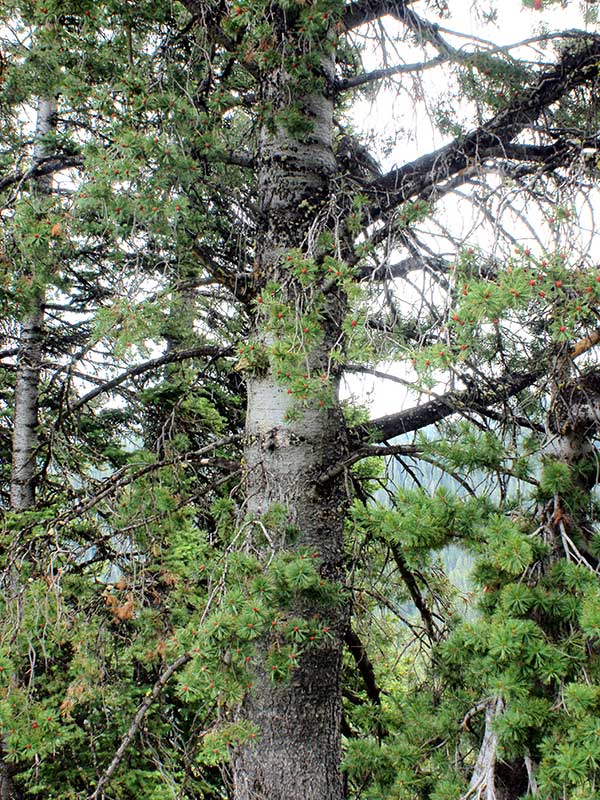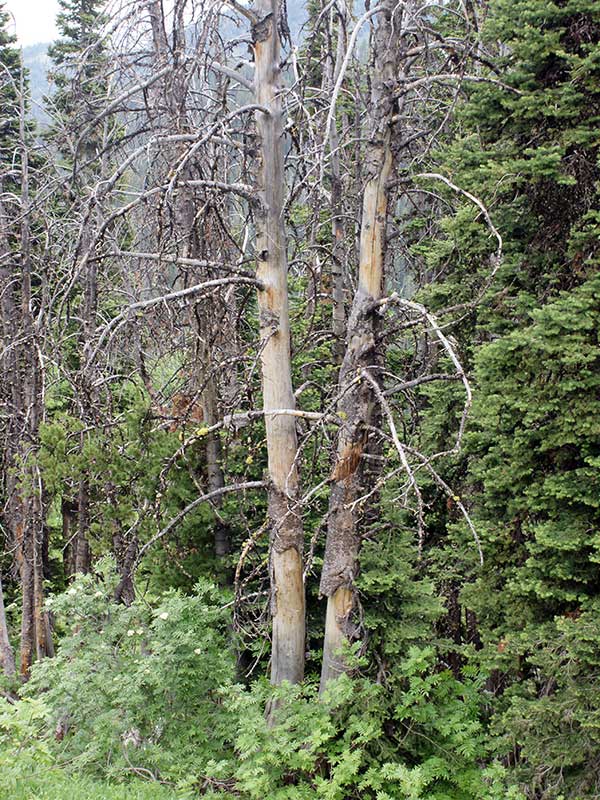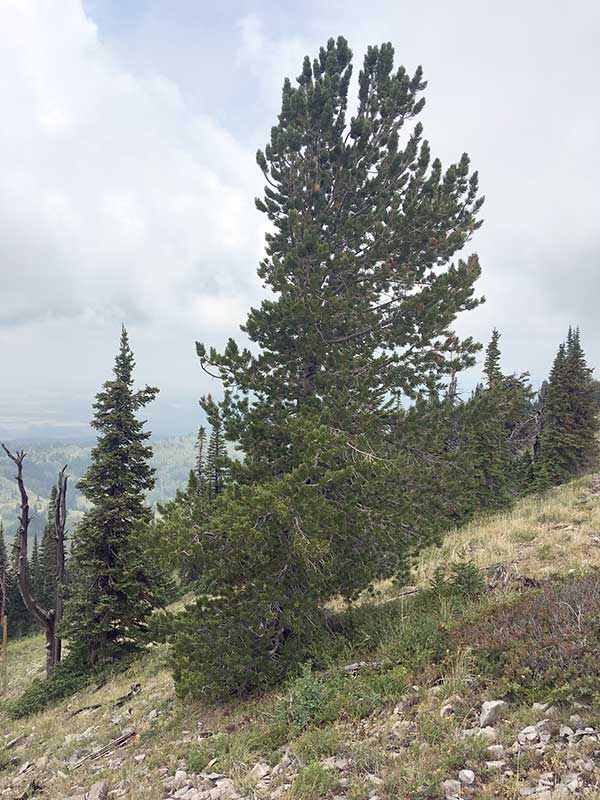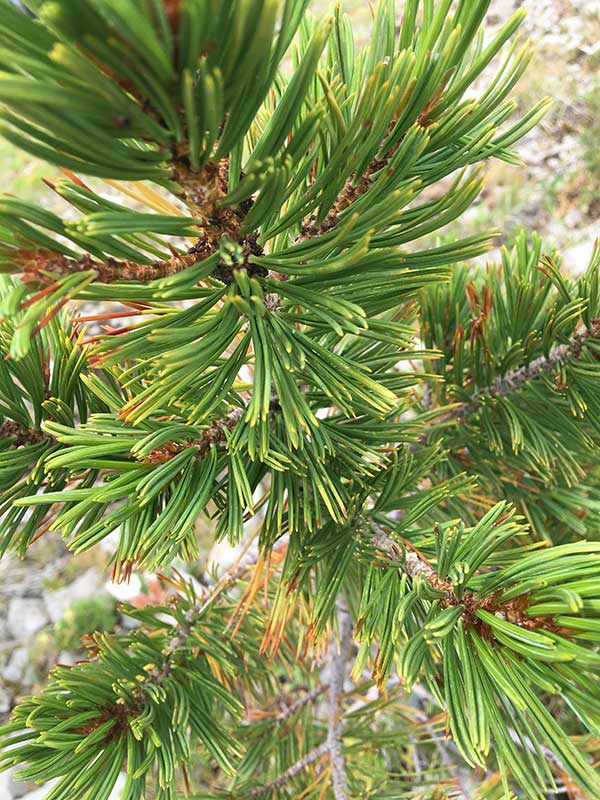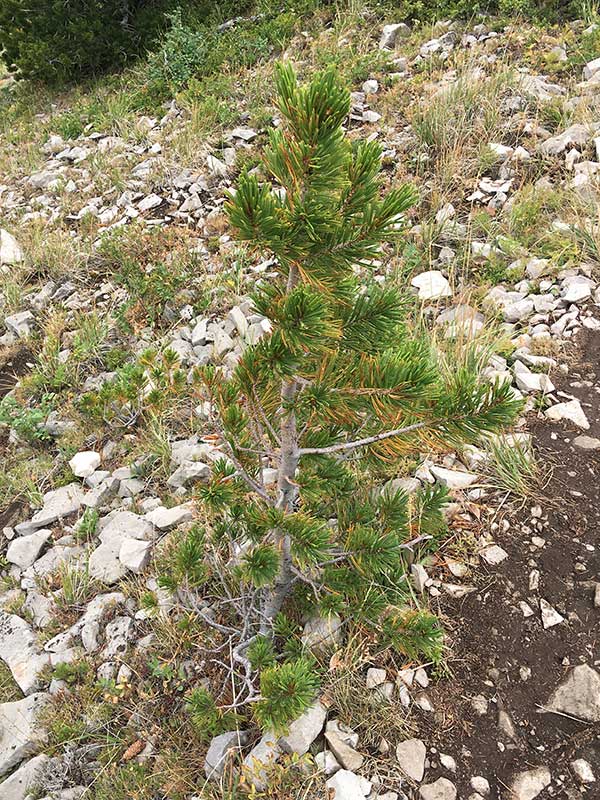Pinus albicaulis / whitebark pine
- high altitude – subalpine to alpine; cold, windy sites
- five needles in tight fasicles
- brown to purple cones at top of tree; cones don’t open
- scaly grayish bark
See also: Pinus flexilis / limber pine
Whitebark pine is one of two 5-needled pines in the Valley, the other being limber pine. It is interesting for a number of reasons, not least of which is that it is classified as a stone pine. There are only five stone pine species in the world. These are distinguished by having large, dense seeds (stone-like) without wings. Winged pine seeds can drift some distance on the wind, but whitebark can’t. Instead, they depend on birds – particularly Clark’s nutcracker – and squirrels for dispersal.
Whitebark pine is a high altitude tree, growing up to 60 ft tall, and, rarely, up to 5 ft in diameter. To get to that height takes many years, of course, and these trees may live for 500-1000 years. From a distance and in sheltered locations, the crown is rounded or irregularly spreading. Because of its restrictions to high, cold, windy sites, however, such stature is rare. At the other extreme, they are shorter, even shrub-like. This form is called Krummholz, from the German krumm, meaning crooked, bent, or twisted, and Holz, meaning wood. Although in the most stressful conditions, it grows as the only tree, it is accompanied by other conifers on moister, more protected sites.
Whitebark pine bark is thin, scaly, and grayish (imagine it dirty white, maybe). The needles are 1.5–3 in long at the ends of upswept branches. Like other pines, it is monoecious. The male, pollen cones (strobili) are small and scarlet in full bloom, growing in clumps beyond the needles. The female, seed-bearing cones are larger and on the upper branches of the same tree. At maturity, these are purple to dark brown and less than 3 in long. They do not open at maturity to release and disperse the seeds.
Interesting bits – Actually, everything about this tree is interesting. Anyhow, the seeds of whitebark pine are dispersed almost exclusively by Clark’s nutcrackers, a jay-like bird of high altitude forest habitats. A single bird can cache up to 90,000 seeds in a good crop year. Because of its restriction to high, cold, windy sites – places where even other conifers have a hard time living – whitebark stands are geographically isolated from each other and survival always tenuous. Consequently, Clark’s nutcrackers are important symbionts for the regeneration of the trees, and critically influence their distribution and population structure.
At least 20 species of mammals utilize whitebark seeds, including ground squirrels which cache entire cones. Again this is important for tree establishment, but it is also critical to bears because they raid those caches. The seeds are particularly high in energy (fats and oils), making them a sought after food in late summer.
Whitebark pine is considered a keystone species for the alpine ecosystem because its shade and the snowdrifts that pile up against it slow the progress of snowmelt. It also helps reduce soil erosion by growing quickly after fires or other disturbances. Once established, it creates shade and modifies the soil below, making favorable habitats for other species. Thus, it is important in creating and maintaining subalpine biodiversity.
However, the overall whitebark pine population is in decline and it has been proposed that it be designated an endangered species. Several factors are involve in that decline. For example, white pine blister rust, caused by the nonnative fungus, Cronartium ribicola, progressively damages and eventually kills infected trees. Periodic outbreaks of mountain pine beetle (Dendroctonus ponderosae), in this case a native species that attacks mature trees, quickly decimate whole whitebark forests. A hundred plus years of wildfire suppression has resulted in more frequent, bigger, and hotter wildfires that can kill even large trees. Of course, climate change is making everything more difficult. For example, it allows the beetles to complete their life cycle faster – one year rather than several. Between 2007 and 2009, this resulted in a beetle epidemic that killed 80% of the oldest trees. And as has been clear in the last few years, warming has led to bigger and worse droughts, making for more frequent and bigger fires.
In putting together this site, most of the web pages I consult are from small or perhaps state-level organizations. In this case, however, there are fewer of those, and many pages put together by federal agencies responsible for managing forest lands. I recommend reading some before – or after – your next hike to the alpine and subalpine zones around the Valley.
Whitebark pine – by the Greater Yellowstone Inventory and Monitoring Network
Whitebark Pine – Featured Creature – by the Klamath Inventory and Monitoring Network
Why does Whitebark Pine matter? – by the Whitebark Pine Ecosystem Foundation
Whitebark Pine – by the Oregon Fish and Wildlife Office
| Family | |
|---|---|
| Inflorescence type | |
| When? | |
| Where? |

